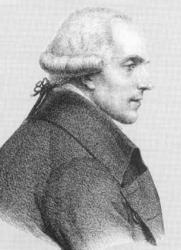




Pierre Simon de Laplace was born on 28 March 1749 at Beaumont-en-Auge, in Normandy, France. Born in a wealthy family, Laplace first studied at a Benedictine College in his home town, after which he matriculated at the University of Caen in 1766. He left Caen in 1768 without obtaining a degree, moving to Paris to work with famed mathematician Jean d'Alembert (1717-1773). Laplace was immediately employed at the Ecole Militaire, and was elected to the Académie des Sciences in 1773. He later became head mathematician there.
Laplace's achievements in applied mathematics and astronomy are many and far reaching. Starting in 1773, be applied his mathematical skills to problems in celestial mechanics. He carried out groundbreaking work on the orbital interaction between Saturn and Jupiter, Lunar orbital motion and circularization, the shape of planetary bodies, tides, and stability of the solar system. His work marked the triumph of Newtonian Mechanics, and together with the work of his fellow countryman Joseph Louis Lagrange (1736-1813), established new standards of rigor and accuracy in positional astronomy. His Tables of planetary positions remained in use well into the nineteenth century. Laplace's researches in celestial mechanics culminated in the publication, between 1799 and 1825, of his five-volume Traité de Mécanique Céleste.
In 1796 Laplace published his Exposition du système du Monde, a popular work aimed at describing the current state of cosmological thought. It it in this book that Laplace introduced his nebular hypothesis, according to which the solar system formed from the gravitationally-induced contraction of an initially large, diffuse and slowly-rotating cloud of interstellar gas.
Laplace was evidently as cunning in politics as in mathematics, as he managed to retain the favors of rulers through the French Revolution, the Napoleonic era, and the return of the French Monarchy. In addition to his purely scientific honors, In 1799 Laplace was appointed to the French Senate by Napoleon, and, following the emperor's fall, was given the rank of Marquis by the returning French Monarchy. His staunch loyalty to the latter made Laplace somewhat unpopular in the last decade of his life.
Porter, R. (ed.) 1994, The Biographical Dictionary of Scientists, Oxford University Press.Hoskin, M. (ed.) 1997, The Cambridge illustrated History of Astronomy
 To search for a Solar Physicist
To search for a Solar Physicist
![]() To references and further reading
To references and further reading
last modification on january 18 2008 by
paulchar@astro.umontreal.ca
Tous droits réservés / Copyrighted by
Université de Montréal